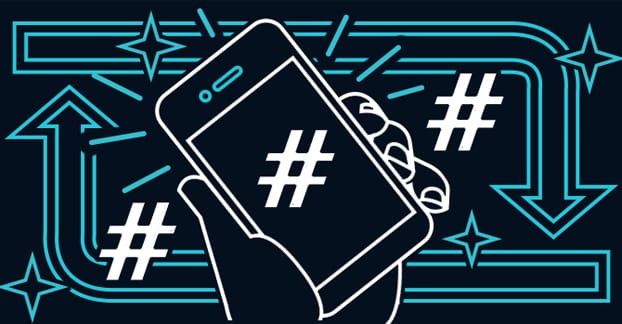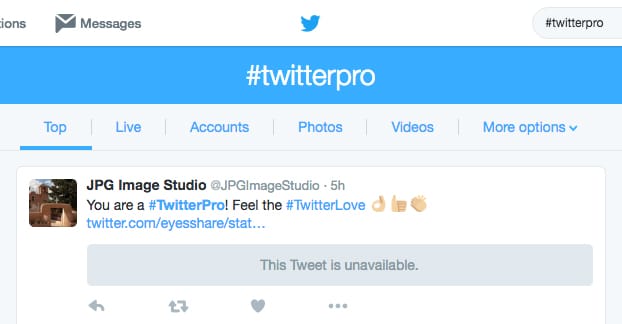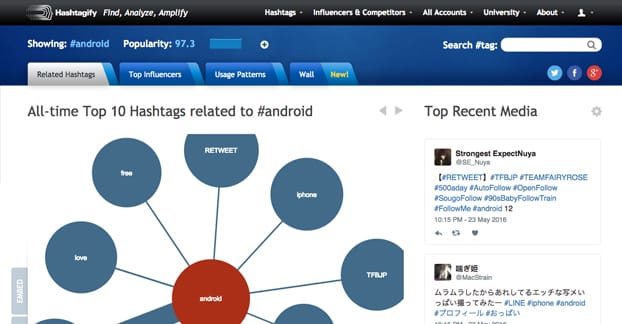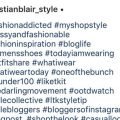Hashtags are an interesting concept with web marketing. They’re present on many platforms, and can be implicitly present without actually including value on other sites. I can type #hashtag here but it won’t be a link, it won’t be clickable, and it won’t give you any value. That’s what hashtags are like on some platforms, like Reddit. Other sites, like Facebook have clickable hashtags, but their value is minimal. Facebook hashtags actually sucks the life out of your campaign, lowering your engagement and click rates.
Meanwhile, platforms like Twitter and Instagram, with their otherwise unfiltered or lightly filtered feeds, have a lot more use for the categorization present in hashtags. They’re central pillars of marketing on those sites, so you need to know how to use them.
I consider hashtags to be a varied entity, a category more than a single thing.
There are many types of hashtags, which I’ll loosely cover here.
- Branded Campaign Hashtags. These are things like #MacysSale or what have you. They have a brand name, a product name, or some other proper now, acronym, or otherwise specific marker for your company and brand in them. They are used by you and by your customers to talk about the specific thing mentioned. At the top level it would just be #Macys for a brand name discussion, but it can go all the way down to specific products or specific marketing campaigns. Generally, you want to be using branded hashtags for your marketing, changing the campaign-based tags out when you change over campaigns. This allows you to track discussions about various topics, and the popularity of those topics.
- Unbranded Generic Hashtags. These are tags that relate to you generally, but aren’t specifically yours to control. For example, if you’re a clothing store and you’re selling spring beach wear, you might use a tag like #beachwear when you’re talking about your new line of swimsuits. This gets the attention of people who don’t know or care about your brand, but do care about beachwear, bringing them into the fold. They’re outreach tags, relevant to you, but not limited to just the people who already know about you.
- Super Generic Hashtags. These are tags that have hundreds of thousands or millions of people using them at any given time, which makes them virtually useless for most forms of marketing. You can’t dominate them, you can’t run them, you can’t rule them; you can only use them. They’re tags like #cute and #happy. They don’t have much meaning for you as a brand, but you can still monitor them and use them sparingly when you find a good opportunity.
- Humorous Hashtags. These tend to be lengthy, overly specific hashtags that people aren’t using for anything other than the punchline to a joke. #OverlyLongHashtags might be one on the nose example. These are only useful as Twitter-themed jokes, not as any actual marketing use.
- Socially Relevant Hashtags. These are hashtags dedicated to and dominated by social movements. Things like the recent #blm tags fall into this category, as do various political movements. These are minefields for marketers; if you try to step in to use one for marketing, chances are you’re going to find a swift and furious backlash. Emotions run hot in these tags, and they’re not filled with people who you would consider potential customers.
- Spam Hashtags. These are pretty rare, but sometimes spambots will make up tweets using some kind of markov chain generator or random word selector, and will make hashtags that make no sense. No one uses them, they don’t matter, and they’re probably not even real words. Don’t worry about them.
Branded hashtags are tags you make up for your marketing. You don’t need to worry about those being good; you’re creating them from scratch and making them good. Generic tags are often too broad and not valuable enough to worry about. Socially relevant tags should be avoided for marketing, and spam hashtags are valueless. Humorous tags are potentially valuable, but not for their tag-ness, so don’t worry about them either.
Thus, the only kind of hashtag you need to monitor and check out are the unbranded generic tags that have some kind of industry or product relevance. These ideally have large enough audiences to be attractive targets for your marketing, while also having an openness that allows you to get in and do your thing, as opposed to being dominated by another brand already.
A couple years ago, Twitter published a flowchart of how to choose a hashtag to use. Let’s follow it and see how relevant it is today.
The Twitter Flowchart
The first question they ask is whether or not the hashtag you have in mind is being used. This is an important question! If the tag is not being used, it’s not valuable to you from a marketing perspective, at least, not for capturing an existing audience. You can turn it into a central marketing tag, but it will take a lot of long term effort.
What you’re looking for are tags that have some use, but aren’t overly generic. Tags that relate to your industry and to your niche, but aren’t tied to a brand or a product. You can’t step on the toes of another brand by hijacking their branded tags.
Following that branch of the chart, the next question is whether or not you’re adding value to the existing conversation. Now, ideally, when you post using that tag, you’re doing it in one of two ways. Either you’re trying to start a new branch of the conversation, or you’re bringing something to the table that participates in the existing conversation.
Say you want to promote a blog post. That blog posts answers a question. The tags you should be looking for are tags that relate to that topic, where people are primarily asking that question and discussing the answers. You want to be able to step in and say “well, I did some research into this topic, and here’s what I found.” People who check the tag discussion will see your post and will be able to click through, have their question answered, and will be able to continue the discussion from there.
As for starting a new branch of conversation, the best way to do this is to ask a question in your post. If your post is providing the answer, you don’t have much room for the discussion to take place. Instead, you need to take a topic, cover it logically, and end on a question that begs more investigation. Don’t do that investigation yet; leave it open-ended for discussion on Twitter or what have you. Then, when you’re drumming up conversation about it, do your research and write a follow-up that answers the question.
I like to use a one-two punch combo of hashtags here. The first “question” post and the first few conversation posts after it should have two hashtags; one being the popular tag you’re using to poke an audience, and one being a disused general or branded tag you create to spin off the conversation. Eventually you can cut out the original tag; the people participating are already there, and will follow you to the branded conversation tag.
The third question in the flowchart is whether or not you intend to use promoted posts to assist with your conversational growth. Of course, answering “no” here is a faux pas as far as Twitter is concerned, but that’s fine; they’re promoting their own ad services and obviously want you to spend money on them. Yes, your chances of getting a huge boost to traffic are reduced when you don’t pay for more traffic. You don’t need to pay to promote every single post you make, though.
That’s more or less it for the Twitter flowchart, as far as we’re concerned. The question is, how do you go about finding those tags and using them?
The first thing you want to do is brainstorm ideas. You don’t need to have specific hashtags in mind, though; just keywords and topics relating to the post or conversation you want to start. This is the basis of the conversation you’re going to run, and you will refine the ideas throughout the process.
The tool I like to use for research at this point is Hashtagify. It allows you to plug in a keyword, concept, or tag, and it will show you statistics about that tag, as well as spinoff tags that may or may not perform better. For example, the current “mothersday” tag has other associated tags circling it, like Etsy, gifts, and deals.
Plug in your braindstormed topics and look for tags that have the right qualities you’re looking for. Remember: no branded tags, no tags that exploit things like FollowFriday, and no overly generic tags like “#marketing” that won’t give you much in the way of attention.
It’s generally a good idea to keep your tags on the shorter end of the spectrum; the longer a tag is, the less space your users have to comment on your tweets or messages while still using it.
A word of warning: you really, really need to check out all of the possible connotations of a hashtag before you use it. The internet abounds with stories about hashtags gone awry. You get examples like the DiGiorno #WhyIStayed fiasco, or the Susan Boyle #Susanalbumparty mess.
Things to watch out for:
- Existing uses of the tag that make your intentions out of line for the conversation. For example, a tag that can mean two different things might be primarily used in the other sense, so you stepping in means you’re derailing a conversation with off-topic content.
- Times when capitalization will change the meaning of the tag. Pen Island without the capitalization or spacing is pretty bad. You can’t always count on capitalization to save you; people will be lazy and the alternative parsing will come out.
- Times when the tag may look innocuous but actually has a deep social meaning. You wouldn’t want to make an acronym that turns into something completely different, right? Don’t try to market a product that has a #BLM acronym, it just won’t work.
- Tags that don’t make sense on their own. If you’re abbreviating something, make sure the abbreviation is clear. You don’t want to try to push a tag that looks like nonsense to someone stepping in out of context. That makes your conversation exclusionary and leaves you bereft of opportunities.
Keep in mind that tags that don’t quite fit the bill for one use might have space in another part of your marketing. If a tag is too generic, you can always include it in a shorter, more generic message. If it’s branded, you can lump it in with other marketing. If it’s a competitor’s tag, you can try to undercut them. Most tags have uses, if you care to contort your messaging in a way such that you can use them.
Other Tools
There are tools beyond just Hashtagify that you can use to research hashtags. Twitter’s native client and search is one such tool; you can see current trending information to try to capitalize on small-time trends happening in your niche. Other tools, though, can be more useful in specific ways.
Trendsmap is a map overlay that shows geographically local hashtags and their trends. If you want to promote a local discussion, or if you want to get a local audience involved, this is the way you can find the right trending tags to do it. It also shows you ideas for what you might want to write about in a local perspective.
RiteTag is a trending tagging app that can be downloaded as a browser extension, showing you trending tags in a real time integrated way. It’s pretty easy to write, schedule, and post tweets while using it to discover tags that are most appropriate for that time specifically.
TagDef is a tag analysis dictionary that you can use to plug in a hashtag and see its current trends, as well as user-submitted definitions of what that tag means and how it is used. This is a great tool to use to run a tag through just to make sure there’s not a meaning you’re unaware of before you use it.
Maybe there’s a tool you like that I haven’t listed. If so, shoot me a comment and I’ll give it a look! For now, these should get you started.





